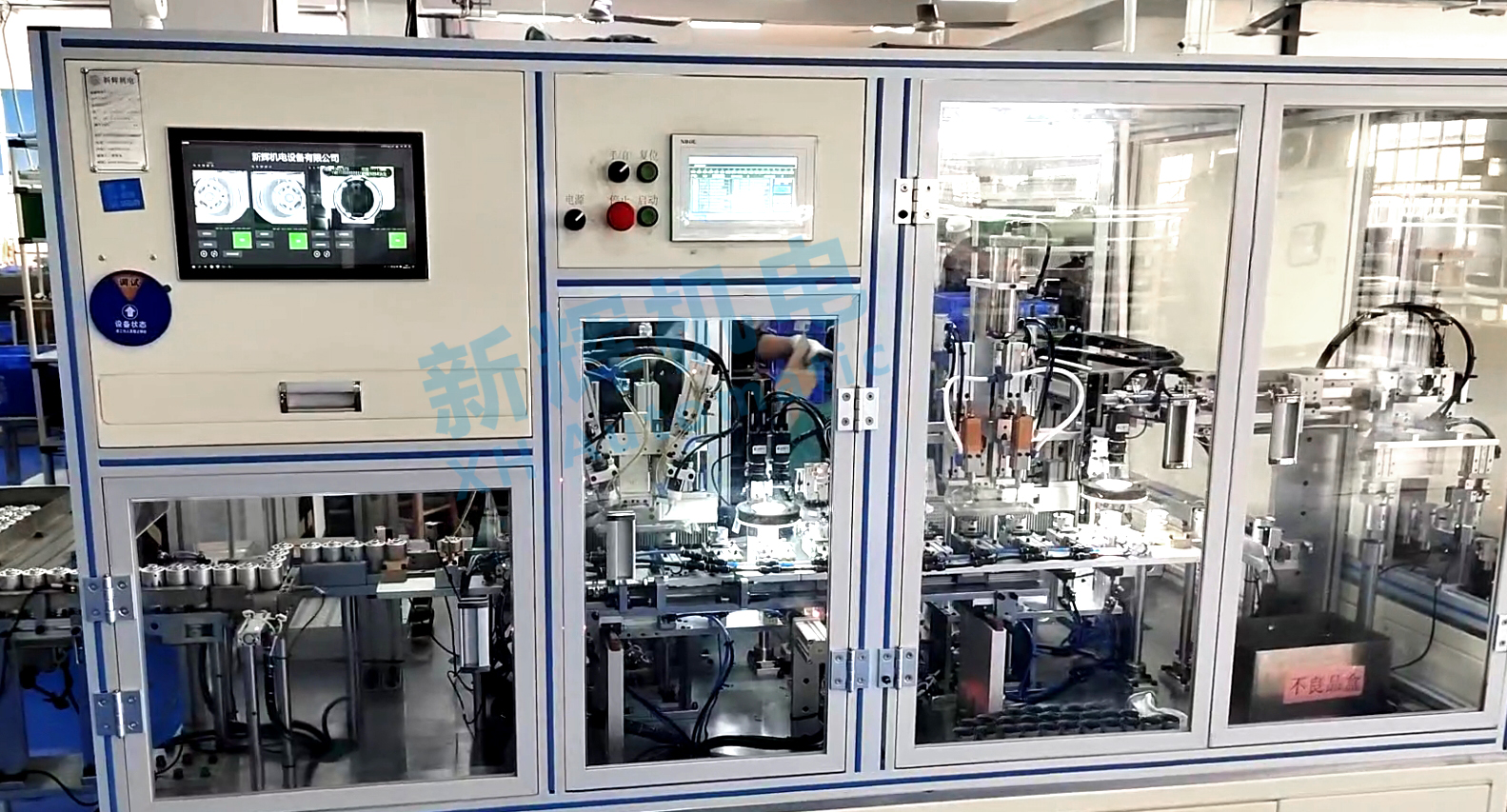What are the common mechanical failures and solutions for DC brushed motor motor automatic case tile assembly machine?
First, the transmission system failure
(A) failure phenomenon
Transmission belt (chain) slipping or broken
The transmission belt (chain) slips during operation, resulting in unstable power transmission of the magnetic tile assembly machine, affecting the assembly speed and precision.
Sudden breakage of the drive belt (chain) stops the machine completely and may cause damage to other parts.
Worn or damaged gears
Abnormal rattling of gears in the process of meshing, which is caused by wear of the tooth surface, deformation of the tooth shape and other reasons.
Gear tooth breakage phenomenon, so that the transmission system loses the normal power transmission function, the equipment can not run normally.

(ii) Cause analysis
Tension problem
For the transmission belt, insufficient tension is the main reason for slippage. It may be due to the transmission belt relaxation after a long time of use, or tension adjustment device failure.
Too much tension in the transmission chain may lead to overstretching of the chain and breakage at the back; while too little tension is prone to tooth skipping, affecting transmission accuracy.
Excessive load
If the equipment encounters excessive resistance during operation, such as mechanical parts jamming, magnetic tile or casing jamming, etc., it will make the load borne by the transmission belt (chain) exceed its limit, which will lead to slippage or breakage.
Gears are susceptible to wear and tooth breakage when the teeth are subjected to excessive pressure under overload conditions.
Wear and Fatigue
Transmission belts (chains) and gears are subject to wear and fatigue during long-term operation due to friction and periodic stress. For example, rubber aging of transmission belt, pin wear of chain, and tooth fatigue wear of gears.
(iii) Solution
Adjust or replace the drive belt (chain)
For the case of transmission belt slipping, first check the tension adjusting device and increase the tension of the transmission belt by adjusting the tensioning wheel, etc., so as to restore the normal friction. If the drive belt has been aged or badly worn, it should be replaced with a new one in time.
For the drive chain, check whether its tension is appropriate. If the chain breaks, it needs to be replaced with a chain of the same specification and make sure that it is installed correctly and that the number of links and connection of the chain meet the requirements.
Checking and repairing gears
When the gears show abnormal rattling, stop the machine to check the wear of the gears. For mildly worn gears, they can be repaired by adjusting the gear's meshing gap and grinding the tooth surface. If the gear has broken teeth, it must be replaced with a new one, and it is necessary to ensure that the new gear is consistent with the original gear in terms of module, number of teeth, precision and other parameters.
Reduce load and optimize operation
Check the mechanical parts of the equipment and exclude factors that may lead to jamming, such as cleaning foreign objects and lubricating bearings, in order to reduce the load of the transmission system. In the process of equipment design and operation, rationalize the assembly process to avoid overloading. For example, control the feeding speed of the magnetic tile and housing to ensure a smooth assembly process.
Second, the fixture and positioning device failure
(A) Failure phenomenon
Fixture can not be clamped or clamping force is insufficient
The casing or tile cannot be firmly fixed by the fixture during assembly, resulting in positional deviation and affecting the accuracy of tile assembly.
The fixture loosens during the clamping process, causing the case or tile to shake during assembly, reducing assembly quality.
Decrease in the accuracy of the positioning device
Deviation in the positioning of the casing or magnetic tile leads to the magnetic tile not being accurately assembled to the predetermined position of the casing, and problems such as misalignment of the assembly and uneven spacing of the magnetic tile may occur.
(ii) Cause analysis
Wear or damage of fixture parts
The clamping jaws of the fixture and the piston seals of the clamping cylinder (or hydraulic cylinder) may be worn after long-term use, resulting in a decrease in the clamping force.
The mechanical structure of the fixture may be loose, such as loose screws, connecting pin wear, etc., affecting the clamping effect of the fixture.
Loose or worn positioning devices
Positioning devices such as locating pins and blocks may loosen during frequent assembly operations, resulting in decreased positioning accuracy.
Wear on the surface of the positioning device, such as the diameter of the positioning pin becoming smaller and the positioning surface of the positioning block wearing out, will also affect the positioning accuracy.
(iii) Solution
Repair or replace the fixture parts
Check the clamping jaws and seals of the fixture for wear. For worn clamping jaws, repair or replace them; for cylinders (or hydraulic cylinders) with damaged seals, replace them with new seals to restore normal clamping force.
Check the mechanical structure of the fixture and tighten loose screws and connecting pins to ensure the stability of the fixture.
Adjust and repair the positioning device
Check whether the fixing screws of the positioning device are loose, if so, re-tighten them. For worn positioning pins and blocks, repair or replace them according to the degree of wear. For example, for worn positioning pins, repair their diameters by chrome plating, etc., or directly replace them with new ones.
In the process of equipment maintenance, the positioning device is calibrated regularly, and the positioning accuracy is checked using gauges (such as calipers, micrometers, etc.) to ensure that the casing and tiles can be accurately positioned.
Third, assembly mechanism failure
(A) Failure phenomenon
Magnet tile assembly tool is damaged
The tools used to assemble the magnetic tile into the casing (such as push plate, suction cup, etc.) are deformed or ruptured, resulting in the inability to push or adsorb the magnetic tile normally.
The precision of the assembly tools decreases, such as the flatness of the push plate is not enough, the suction force of the suction cup is not uniform, etc., which affects the quality of the magnetic tile assembly.
Uncoordinated assembly action
Problems in the coordination between the actions of transferring, positioning and assembling of magnetic tiles, such as starting the assembly before the tiles are fully positioned, or not transferring the tiles away in time after the assembly is completed, resulting in a chaotic assembly process and reduced efficiency.
(ii) Cause analysis
Tool material fatigue and overload
The assembly tool is subjected to a certain amount of pressure and friction due to frequent contact with the magnetic tile during the long-term working process, which may lead to material fatigue, deformation or rupture.
If greater resistance is encountered during the assembly process, such as over-tightening of the fit between the magnetic tile and the housing, the assembly tool may be subjected to overload pressure, accelerating its damage.
Failure of control system or wear of mechanical parts
Failure of the equipment's control system, such as program errors and delayed signal transmission, may result in uncoordinated assembly movements.
Wear and tear of mechanical parts, such as wear and tear of the conveyor track and increased clearance of mechanical transmission parts, may also affect the accuracy and coordination of assembly movements.
(iii) Solutions
Replacement and calibration of assembly tools
For damaged assembly tools, such as deformed push plates or cracked suction cups, replace the tools with new ones in a timely manner. After replacement, calibrate the new tool, such as checking the flatness of the push plate and adjusting the suction force of the suction cup, to ensure that it can meet the assembly requirements.
Regularly inspect and maintain assembly tools, and use suitable materials and processes to make assembly tools to improve their durability.
Inspection of control systems and mechanical components
Check the control system of the equipment to see if there are any errors in the program and if the signal transmission is normal. If necessary, debug and modify the control program, or check the electrical wiring and sensors to ensure that the signals can be transmitted accurately and timely.
Check the wear and tear of mechanical parts, and repair or replace the worn transmission track; for mechanical transmission parts with increased gap, adjust the gap or replace the parts with new ones, in order to restore the coordination of the assembly action.
※ If you still can't solve the equipment failure by the above ways and means, please contact the technical specialist of Xinhui Electromechanical Equipment Co., Ltd. through the page chat tool to seek help.







